- New data shows that submitting ACT or SAT scores significantly improves a student’s admission chances.
- Why the conventional wisdom about when to submit scores to test optional schools is flawed.
- Why selective colleges are reinstating test required admissions.
Speaker: Adam Piacente of Marin SAT Prep. Recorded at the Belvedere-Tiburon Library April 20, 2024.
Transcription:
{ 0:00 }
First thing first: let’s talk about how important the tests really are. Because there is a lot of conflicting information from a lot of different sources about what is important. How important are the tests? Do I really need to take them? The information a lot of people are getting about this is actually, I think, a bit misleading from major media publications on this. And there’s been a real emphasis to sort of downplay the importance of the test.
As we’re going to see, probably to the detriment of people who are applying to colleges, because the impression they’re giving about how important the tests are isn’t really accurate as to what they are. And we’re going to see why in a minute. We’re also going to see why what your college counselor is telling you about how to use your scores and when to actually use them in your application is probably not correct either.
{ 0:56 }
How important are these tests?
So first of all admission tests: required or optional. What is test optional. What does that really mean?
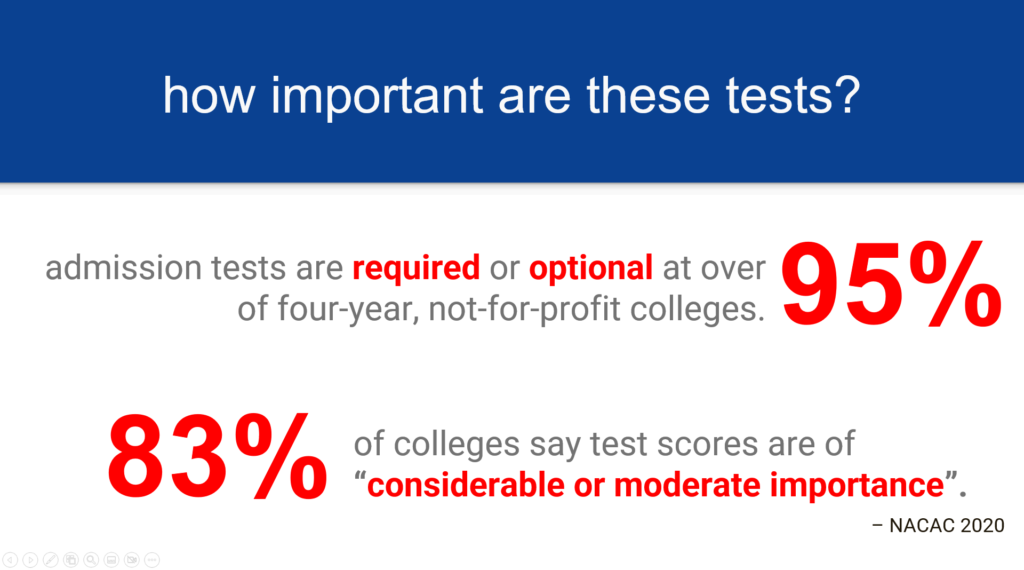
We’re going to talk about that but the tests are required or optional at over 95% of schools. 83% of colleges say test scores are considerable or moderate importance. The reason they want to see these scores and this is really important – the UC system did this in depth study and because they’re such a big system, had a lot of data to work with and did this basically 200 page report. If you really want to geek out on this stuff, read this report.
But basically they found that the test scores are a better indicator than anything else of college readiness. And college readiness basically means: are you going to survive the first year? Because if you survive the first year of college, chances are you going to graduate. And that’s what admission counselors are there for. They’re there to decide whether or not your student is going to make it through the curriculum of the school. And if they make through first year, chances are they’re going to go on and graduate because the vast majority wash out before the first year’s over.
{ 1:55 }
So the scores are actually the best indicator of that. What they found was the grades are a good indicator, scores are a better indicator and the scores and grades together are the best indicator. So it’s really a multiplier effect. So if you get rid of those scores, all you’re left with are just the grades down here you don’t really have that multiplier effect. And this is going to become important as we talk about test optional and how it’s really playing out in in the real world now that they now that a lot of school has gone to it.
Required vs. Optional
OK, so let’s talk required versus optional. So required is just basically the old school thing for test required schools. All students must submit either ACT or SAT scores when applying. Now some people say, well the ACT or the SAT, do they take one or the other? Because when we were all kind of growing up, that’s how it was. Now everybody takes either the ACT or the SAT.
{ 2:59 }
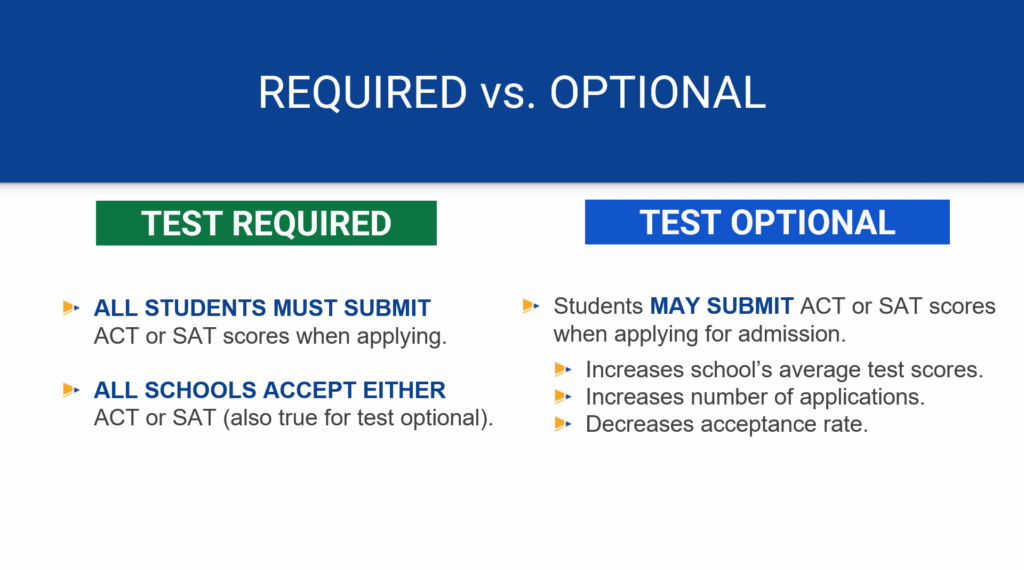
Test Optional. All right. Students may submit ACT or SAT scores when applying for admission.They basically are taking out the bottom third of the SAT scores and opening it up to open admissions. That’s how it’s working. And we’re going to see more about this in a sec, but the impact of that is if you take out the bottom third of your SAT scores, well, all of a sudden your average SAT scores are going to go up because you’ve just cut out the bottom third of all the numbers, right?
So what you saw in the wake of test optional was all of a sudden all these schools – their SAT numbers all of a sudden went up. They didn’t do anything different. They just cut out the bottom third of the students basically so that all their scores on the average went up overall. It increased the number of applications as well. You’re getting a lot more applications from a lot of different places because now all of a sudden, you know, Yale does test optional. They don’t require scores and everybody wants to apply to Yale.
{ 3:59 }
So they get swamped with non test applications and it decreases the acceptance rate because if you’re getting all these more applications all of a sudden the acceptance rate in general goes down. So for all these reasons these are good things for the school: your average SAT scores go up, you’re geting more applications. Somebody said that, you know, I read somewhere where the increase in applications may generate about 5 or $6 million extra revenue for the school, I mean this kind of thing. And then it decreases the acceptance rate.
So again, you see a more desirable school. They haven’t actually done anything in terms of improving the student body. They’ve just basically playing this game with the SAT scores, with some people having the option to do it or not.
Are ACT and SAT Test Scores Really Optional?
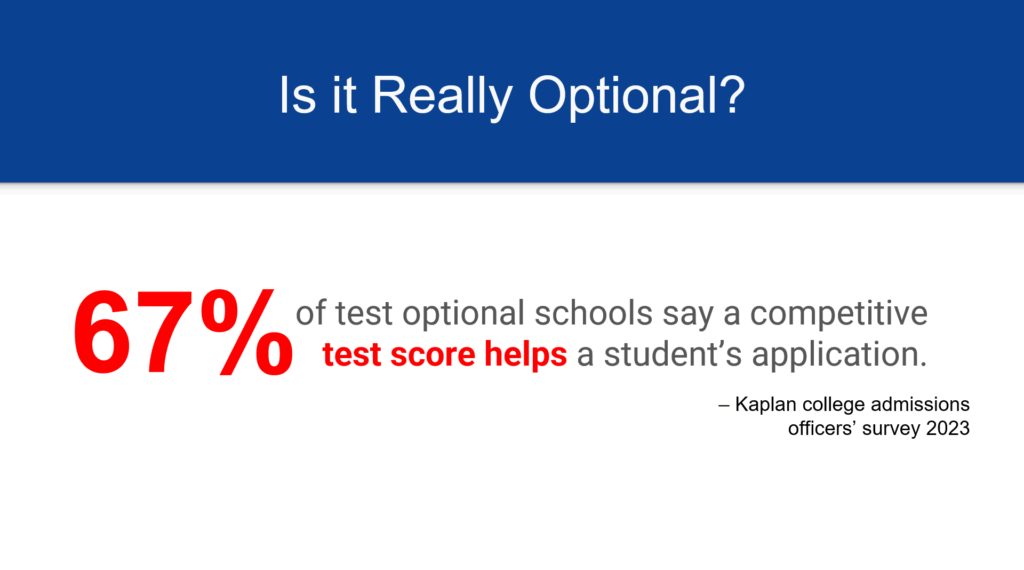
{ 4:57 }
OK. So even with test optional, 67% of test optional schools, not all schools – that’s 80 something percent. 67% of test optional schools say a competitive test score helps your student application. OK, it’s still going to help you. And let’s really talk about why.
Submitting Test Scores Greatly Increases Chances of Admission
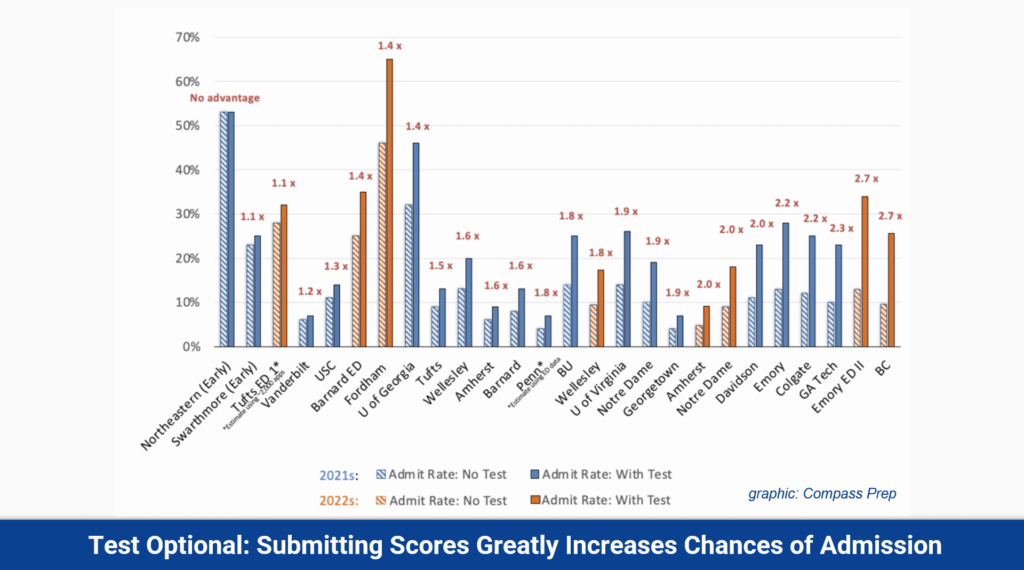
{ 5:57 }
The lined bar is the admissions rates for students who did not submit scores, whereas the solid line is the admission rate for students who did submit scores. So Boston College keeps coming up. So let’s take that at the end here. Boston College had a little bit under a 10% admit rate for students who did not submit scores. But you know, looks like it’s almost a 25% rate for students who did submit scores. So the rate that they were admitting students at Boston College last year was 2.7 times for students who did submit scores over students who didn’t.
And if you look at all of these schools, you know the only time it actually comes up to even is in sort of these early decision ones. And that’s great because they’re letting in the early decisions students, they’re letting in a lot of legacy students and things like that they don’t really want to see their scores. So on the early decision side, they’re more willing to do it. But once you get into the regular pool, you know, all of a sudden you’re two times more likely to to get in basically if you submit scores than if you don’t. Make sense?
So when they say test optional, you know, it sounds like, “Oh, we don’t have to submit scores. They don’t care one way that it won’t matter.” It really does matter because for these schools it’s these tests that are really all about helping them find out who’s going to make it through first year. That’s why the schools want the scores in the first place and if they don’t have them, they really can’t tell.
Why Your College Counselor is Wrong About Test Optional
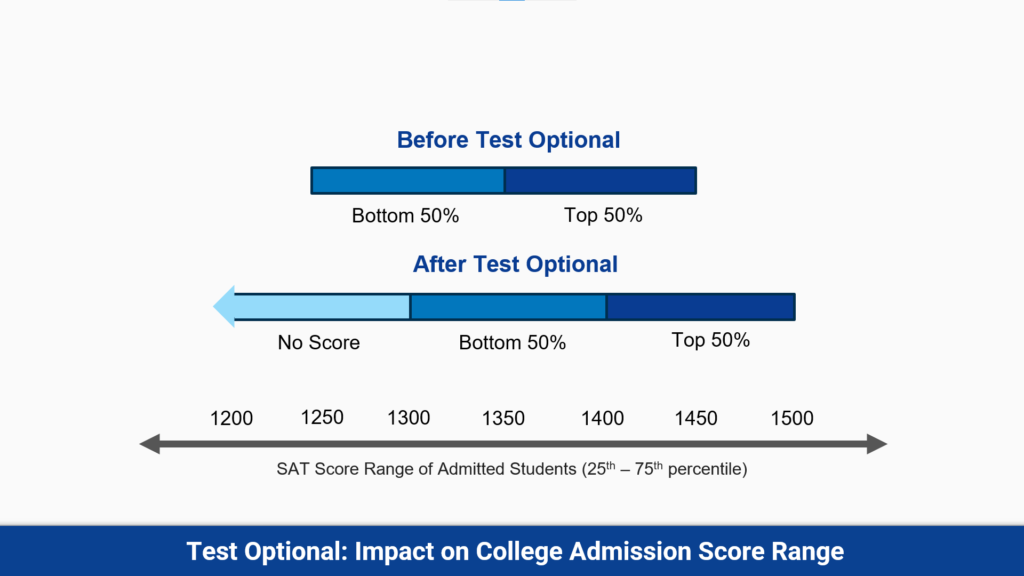
{ 6:54 }
So before test optional. let’s say this was your average score range here. And this is just a hypothetical school. This isn’t any specific school in general, but hypothetical school score range and the score range, by the way, it is when they say top 50, bottom 50, that score range, that’s the 25th to 7th percentile. That’s the middle 50 percentile of people in the score range. But just to just to be clear, let’s say the score range here for this school was 1250 to 1450. That’s basically if you look on any sort of score range for a school, that’s what they would promote. That’s what they would publish.
So if you had a 1350, you’re basically straight in the middle of all the students taking the SAT, and even if you’re in the bottom 50 if you’ve got some good grades you’re pretty much going to get in. It’s only when you get to the bottom of that 50 like around 1250 or even below it that you’re kind of on the bubble.
{ 7:45 }
After test optional. This is what it starts to look like.
They lop off that last part and they say OK, well if you’re below say 1300 we’re we’re going to kind of put you in the pile with the students who didn’t, and we’re going to see how that works, and the bottom 50 to the top 50 – that all shifts up.
Now let’s be clear, it’s not that there are so many more students at 1450 to 1500 that are applying to these schools. In fact, the test scores themselves have have stayed pretty even if not have gone down a little bit. So it’s not like they’re getting more 1500 students. It’s just sort of statistically this is what it starts to look like if you lop off all those bubble students at the bottom and just determine we’re not going to count those scores at all, Does that make sense?
So it’s not as if they’re just becoming a better school. It’s just statistically, this is how the numbers kind of work out when when you implement test optional. But the thing about it is, and this is why I said your college counselor’s probably telling you the wrong information about this. So a lot of college counselors, and I have a lot of friends who are college counselors and I love them to death. But on this topic, they are not correct here.
{ 8:59 }
Basically, it has become sort of a mantra for college counselors to tell you how you deal with test optional. What your college counselor tells you to do for test optional is if you’re not in the top 50% of SAT scores for Test Optional schools, don’t send your scores. Talk to college counselors, that’s what they will tell you. OK. In my opinion, it’s completely false. OK? Because here’s the deal: what they’re saying is that if you have a 1350 now, which is in the bottom 50% of the new under test optional where it used to be right in the middle, you shouldn’t submit your score. You should only submit your score if you’re over 1400. All right? But let’s think about that for a minute. Let’s say you have a 1350 and you don’t submit your score. They’re going to assume you don’t have a 1300. They can’t assume you’re actually in the score range. Because if you were, why wouldn’t you submit scores in the first place?
{ 9:58 }
They don’t know that your college counselor told you not to submit scores. So you’re actually hurting your chances by not showing hey, I’m in the range which the SAT scores show are going to get me through your through your school. I can handle the work. You see what I’m saying? So when a college counselor says that it just doesn’t make any sense to me. This is helping your score. This is going to help your application. If you’re in that range, regardless of what it is that’s going to help your application.
I would argue that even if you’re down below say, 1300 in this example, you should still submit scores because who are you competing with? Somebody who may have a 1200? You know, you can say, OK, I got a 1290, I got 1280. Well, they’re going still look at you a lot more favorably than the vast majority of no score students because they have no idea about those students. And that’s what a lot of schools are saying.
{ 10:58 }
A lot of schools are coming back to test required. We’re going to see this in a minute. But a lot of things they’re saying is that we went test optional for a couple years and it’s not working because a lot of students who would have gotten into our school didn’t because they didn’t give us their scores. That’s what’s happening now. And so they really don’t know. And especially at that bottom level, those are the where the scores are important. If a student has a 1400 versus a 1450, you know they’re going to do well at that school. It’s going to be fine.
But what the college admission counselors really want to know is where the bubble is. That’s where we really need the scores and that’s the ones that they sort of washed out. If you have 1200, you’re really outside of the range, like 100 points out. Yeah. Maybe you don’t want to submit that. But if you’re anywhere close, if you’re somewhere in here? That used to get you in anyway. Don’t write it off because you’re not in the top 50%.
{ 11:55 }
I wouldn’t even write it off if you’re if you don’t even make the bottom 50%, because if you’re close, you’re competing with a third of the students who aren’t submitting scores at all. They know they have a much better idea of you, and they know that you’re at the top of that list because if you’re not submitting scores at all, there’s no way they can assume you’re going to be within that range. I mean, why wouldn’t you submit scores if you were in the range? You see what I’m saying? And this is why it’s really important. This is why what people are telling people about test optional really isn’t playing out in real life. And that’s why the scores are extremely important – much more important than they are leading people to believe.
Colleges Reinstating Test Required Admissions
{ 12:47 }
And the pendulum now is starting to swing back. Just in February, every day there was another article of some school that was switching from test optional back to test required: Dartmouth, Brown, MIT, Yale. That’s why these highly selected schools are all going back to this because they can’t tell – they’re getting swamped applications from people. Yeah, a lot of people have good grades, but we don’t know anything else about them. Those scores are really good at breaking down specific areas of weakness and strength. This is why they gave the test in the first place.

And so a lot of these schools say it’s not working for us and it is swinging back to tests required. Now where all these selective schools go you know that the other schools are going to follow if not next year than the year after. So if you’re planning in the future it’s you know, “Oh I can just go test optional. I don’t want to deal with the whole thing about SAT.” It’s really hurting your chances. It really is not an easy way out on this at all.
OK any questions on any of that? OK. I think I’ve made my point, huh? Alright.
Q: Adam, how do you really feel about?
{ 13:57 }
Yeah, right? Well, you know, in Fall of 2022, I was here saying I thought they were over their skis on this. Because it was just going to be much more trouble for them than it was worth. I mean they’re taking away their best tool. Their job is to make sure that – you know if there’s a lot of dropouts that’s on the admissions office. So they don’t want that right? So what they end up doing in my opinion. This is, you know, with those schools that went back, they all said it doesn’t help.
Like under underprivileged students, it really doesn’t help because most of them were not submitting scores anyway, when if they had submitted scores that were at the lower or below the range, they would have gotten in. They didn’t submit them, so they can’t find them anymore. And that was one of the main things the SAT was designed to do in the first place, was to find what they call diamonds in the rough, which, you know, students who maybe didn’t do so well in school but actually had aptitude.
{ 14:58 }
And that’s not just for under priviledged; it’s for any students. You know, you don’t always have a clean ride through four years, right? And not everybody’s always a great student for those four years, right? But it’s to find students that have aptitude that maybe just didn’t do well in their educational environment. And that was what the SAT was originally designed to do way back when in the 50s. And so you get rid of that basically for those students that you know that you need it for. You’re really not finding them.
That’s what they complained about. Yale specifically talked about that they said we’re reinstituting because that is what we’re getting. We can’t process this and we’re getting flooded with them. And so we’ve got to bring the test back. As I said it’s not just the big schools. All schools are dealing with this right now and and so the pendulum seems to be – the trend seems to be swinging back.

